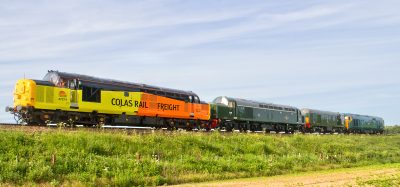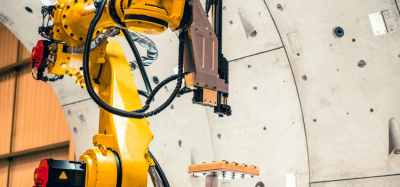OFF THE RAILS: Connected Places Catapult’s Head of Rail Business Development, Kristoff van Leeuwen
Posted: 2 May 2024 | Emily Budgen | No comments yet
In this week’s ‘Off the Rails’, I spoke to Head of Rail Business Development at Connected Places Catapult, Kristoff van Leeuwen.


What was your route into rail?
My route into the railway industry wasn’t entirely traditional. I’ve spent my career in research and development, and in 2016, that led me to the Transport Systems Catapult (now Connected Places Catapult). There, I started as a Project Manager on rail innovation projects, directly partnering with the Department for Transport (DfT). This gave me a fantastic opportunity to dive right into the cutting edge of the industry.
The Catapult then formed a key partnerships with Network Rail and HS2. This opened doors for me to collaborate on a broader range of initiatives, working alongside some of the biggest names in UK rail infrastructure. Over the last four years I’ve transitioned into a business development role for the Catapult, where I work closely with our partners to develop new scopes of work.
What are three characteristics you believe are integral to a successful career in rail?
In my experience, a successful career in rail requires a blend of adaptability, strong analytical skills, and excellent communication and relationship management. The industry is constantly evolving, so the ability to learn and adapt to new technologies as they emerge is crucial. I think everyone underestimates the effort required to take technology from one sector and move it into this one. Finally, collaboration is key to working effectively with diverse teams across the industry.
What is the biggest challenge for the rail industry?
Transform the customer experience and making rail the preferred choice for travel. While rail offers many advantages, like speed, safety, and environmental benefits, we need to bridge the gap between how passengers perceive rail travel and the reality of a comfortable, convenient, and attractive option – most importantly at an affordable price. The good news is that the Great British Railway Transition Team (GBRTT) is already laying the groundwork for a reformed system that prioritises passengers. Their focus on streamlining operations and improving efficiency all contribute to a more reliable and financially sustainable railway. This strong foundation can pave the way for future investments that enhance the passenger experience, such as improved ticketing systems, station upgrades, and better connectivity.
What is an innovation you would like to see in the next five years?
Widespread adoption of a hyperconnected railway built around digital twins. Our ageing infrastructure demands ever-increasing maintenance costs. A hyperconnected railway would leverage a network of sensors embedded in tracks, trains, and stations. This real-time data would be fed into digital twin models, which are virtual replicas of physical assets. By analysing sensor data and historical trends through the digital twin, we can predict equipment failures before they happen. This allows for targeted maintenance, reducing unnecessary downtime and costs associated with reactive repairs on ageing infrastructure. An advanced system like this could simulate different scenarios, allowing for optimised scheduling, routing, and resource allocation. Imagine a system that adjusts train speeds based on real-time track conditions, minimising wear and tear.
To fully realise this vision, the railway industry needs to open its doors to collaboration across sectors. Many industries, like automotive and aerospace, are already heavily invested in hyperconnectivity and digital twins. By fostering partnerships and leveraging expertise from these sectors, we can accelerate innovation in the railway industry.
This vision is expensive but holds the potential to breathe new life into our ageing infrastructure and transform the overall railway experience. Opening the doors to collaboration across sectors can unlock the full potential of this innovation.
Tell me about Catapult’s HS2 accelerator programme.
This initiative is the brainchild of the HS2 Innovation Team, and Connected Places Catapult acts as the delivery partner. It’s a fantastic programme that fosters innovation in the UK’s high-speed rail project.
The program specifically targets highly innovative start-ups in the rail technology space. Through a competitive selection process, five SMEs (small to medium sized companies) are chosen each round. These companies are then supported with a tailored testbed and support programme. They receive expert mentoring, a platform to trial their innovations within HS2’s environment, and back-office and partner support to help them realise the full potential of their solutions. An additional focus is on investor readiness training, equipping them with the skills to secure funding and kickstart significant growth.
The programme is now delivering its 6th cohort of SMEs, and it’s seen a tremendous amount of success. This is a testament to the programme’s effectiveness and HS2’s drive to realising savings from nurturing innovation and shaping the future of HS2.
How are Catapult working with Network Rail?
Connected Places Catapult enjoys a highly productive working relationship with Network Rail, with a shared focus on fostering innovation within the railway industry. Network Rail’s dedicated R&D team plays a pivotal role in this collaboration. They have a fantastic leadership and programme delivery team who excel at facilitating and fostering partnerships across the railway ecosystem.
This collaborative approach translates into several key areas. Firstly, we work together to identify and develop innovative solutions for challenges faced by Network Rail and the wider industry. Secondly, Network Rail’s infrastructure provides a valuable platform for piloting and integrating promising new technologies. Finally, the Catapult’s reach across multiple sectors assists Network Rail in enabling trials, demonstrators, and new ways of working.
A recent example of this collaboration is the Station Innovation Zone programme, spearheaded by Connected Places Catapult. This programme aims to transform train stations into hubs of innovation. Network Rail is a key partner, providing Bristol Temple Meads station as the first testbed zone. Here, we’re working together to trial and evaluate cutting-edge technologies designed to improve the passenger experience, station operations, and overall efficiency.
This year, 2024, is Global Railway Review’s thirtieth birthday, its pearl anniversary. Do you have a pearl of wisdom to share?
The UK boasts a wealth of cutting-edge rail technology ideas. However, the current process for trialling these innovations can be a barrier. By streamlining trial approvals and creating designated testbed environments, we can prevent these promising technologies from migrating to other sectors, like aviation and automotive, who are quicker to embrace them.
Imagine the potential if the rail industry becomes known not just for its rich history, but also for its forward-thinking approach to innovation.
More Like This







